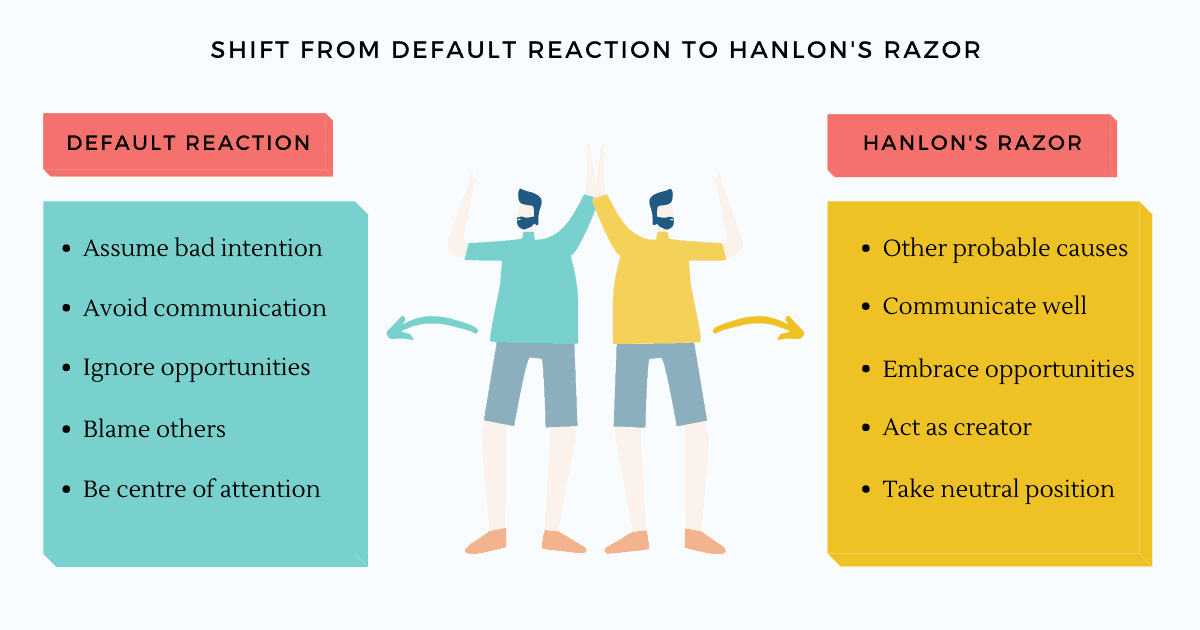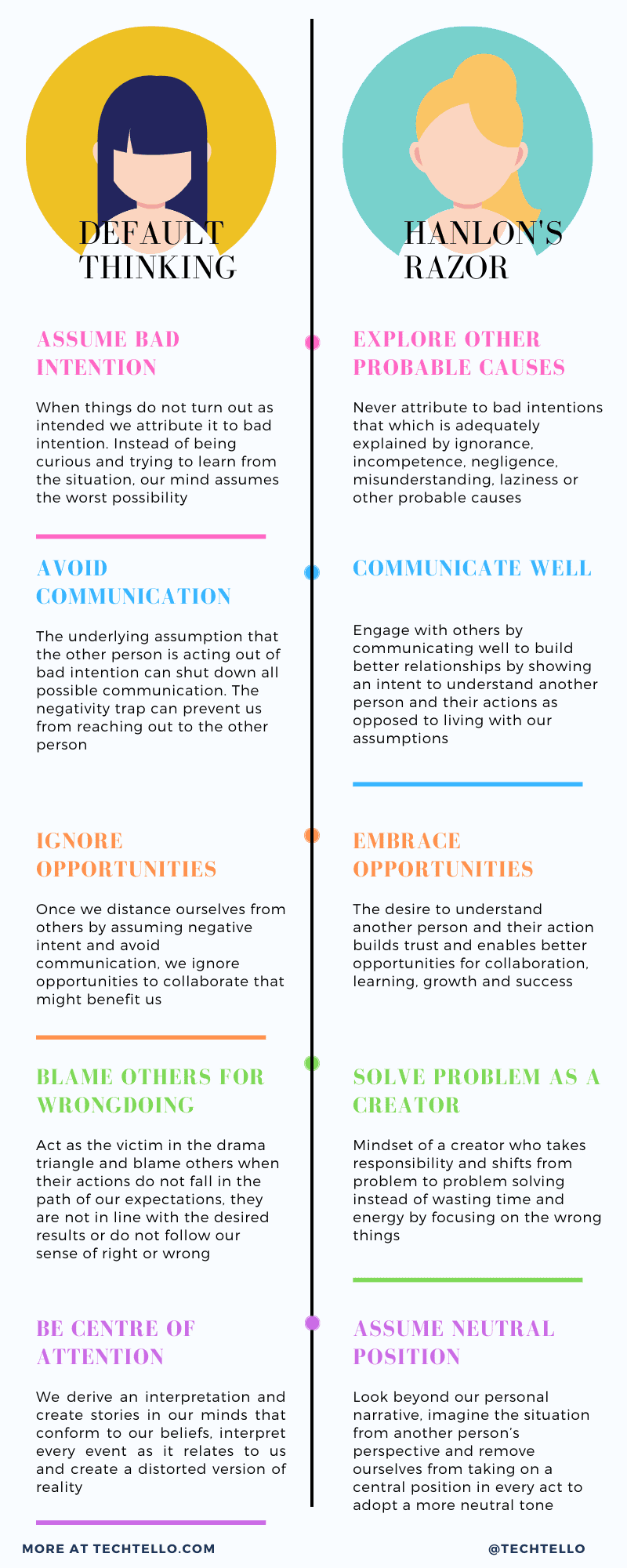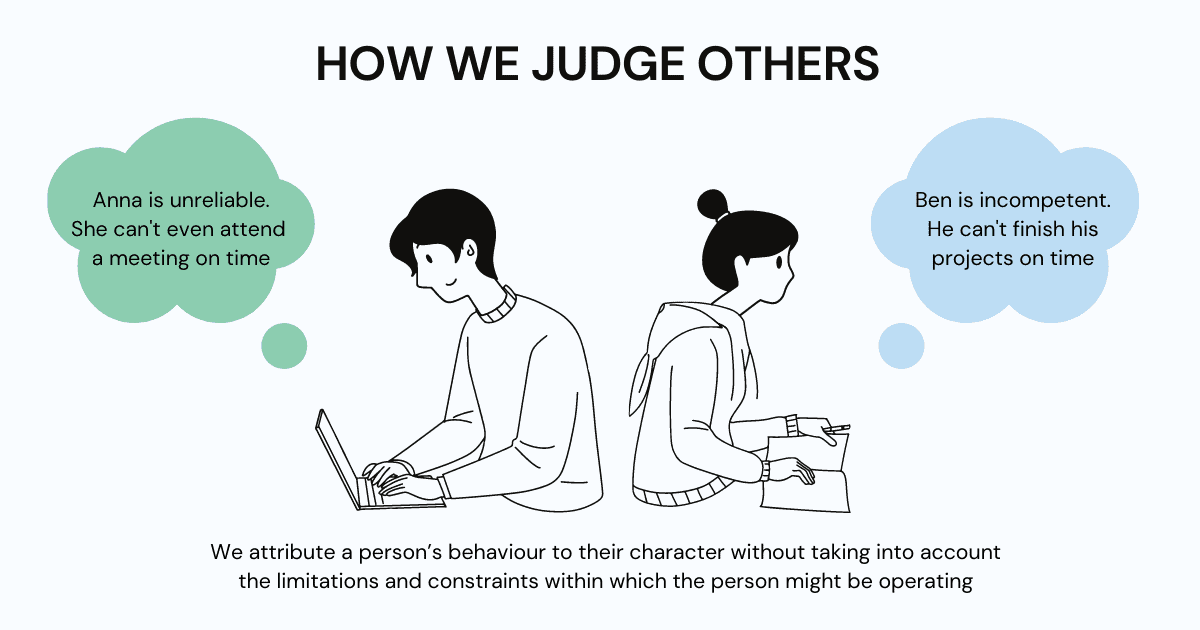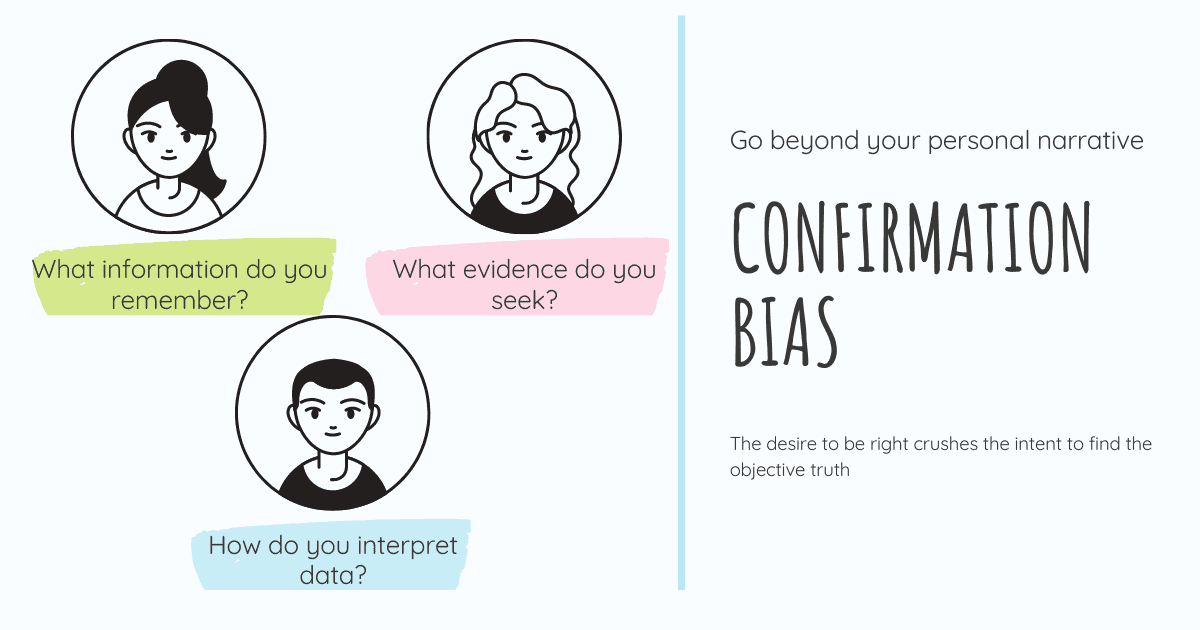Hanlon’s Razor: How To Be Less Judgmental And Build Better Relationships

We humans crave a perfectly ordered world though the chances of something going as intended is fairly rare. When there’s more than one human being involved in the equation, the predictability goes for a further toss.
What do we do when things do not turn out as intended? Instead of being curious and trying to learn from the situation, our mind assumes the worst possibility. Depending on how we see the event unfold, we derive an interpretation and create stories in our minds that conform to our beliefs.
As a species, we are also very unique in associating two completely disconnected stories and finding patterns in events that do not exist. Our tendency to interpret every event as it relates to us creates a distorted version of reality. It makes us assume negative intent when things do not work out even though the outcome may be completely unrelated to us.
For example:
Your boss canceling your 1-1 meeting could be interpreted as their evil intent to prevent you from growing or a more rational explanation could be that they got called into an urgent meeting at the last minute.
Another co-worker refusing to help could be thought of as their villainous attitude to avoid knowledge sharing or another possible explanation could be that they are too busy at the moment to help out.
The ability to look beyond our personal narrative, imagine the situation from another person’s perspective, and remove ourselves from taking on a central position in every act to adopt a more neutral tone requires utilizing Hanlon’s razor as a mental model while evaluating such circumstances.
Hanlon’s razor principle was coined by Robert J. Hanlon which states “Never attribute to malice that which is adequately explained by stupidity.”
Over time, I have developed my own version of Hanlon’s razor that I find more relevant to my work and life “Never attribute to bad intentions that which is adequately explained by ignorance, incompetence, negligence, misunderstanding, laziness or other probable causes.”
Applying Hanlon’s razor as a mental model can enable us to communicate well and build better relationships by showing an intent to understand another person and their actions as opposed to living with our assumptions.
What happens when we do not apply Hanlon’s razor?
The underlying assumption that the other person is acting out of bad intention can shut down all possible communication. The negativity trap can prevent us from reaching out to the other person. It can make us distance ourselves from others, avoid communication, collaboration, and ignore opportunities that might benefit us.
Human beings are uniquely designed to carry the emotional burden of a negative experience in their minds much longer than a positive outcome. This mindset can also lead to overthinking which is detrimental to our health and overall well-being.
Without applying Hanlon’s razor from our toolkit at the right moments, we may end up wasting our time and energy by focusing on the wrong things.
Hanlon’s razor enables the mindset shift from acting as the persecutor in the drama triangle by blaming others for the wrongdoing to taking a moment, stepping back and thinking about other possibilities.
Combating cognitive biases with Hanlon’s razor

Our cognitive biases dictate how we perceive the world around us, how we act, make decisions, and apply judgements.
By living with subjective reality based on how we see things from our perspective, we may provide illogical arguments, make inaccurate judgements, and take irrational decisions.
Hanlon’s razor is a powerful tool for overcoming some of these biases. Let’s look at a few:
Fundamental attribution error a.k.a correspondence bias
Fundamental attribution error is the tendency to overemphasize personality and underestimate situational factors when explaining other people’s behavior. Also described as “what people do reflects who they are.”
Because we judge others by their actions, this bias can manifest itself when other’s actions do not produce the desired results, meet our expectations or do not follow our sense of right or wrong.
The natural tendency in such circumstances is to attribute people’s actions to their personality without taking into account other factors that may contribute to their behavior.
For example:
You may be quick to judge your co-worker who doesn’t attend your party as being envious of your promotion without realizing that they got held up with a personal emergency.
You may think of your boss who does not invite you to an important meeting as insensitive and cold without knowing that the meeting demanded a restrictive audience for other reasons.
Employing Hanlon’s razor during such moments can help us shift from a negative frame of mind to seeking positive or other probable causes that may contribute to this behavior.
Cognitive Distortions Bundle
Challenge and replace irrational thoughts with more realistic and adaptive thoughts.
Confirmation Bias
Confirmation bias is the most profound bias in all human beings in which we seek evidence that confirms our beliefs and refute all data and arguments that contradict it.
The desire to be right crushes the intent to find the objective truth. When confronted with information that challenges our personal narrative, we work hard to find ways to reject the evidence that contradicts our beliefs and look for information that strengthens our point of view.
For example:
If you think your boss is biased, you will look for evidence that rationalizes your point of view while discarding any data that’s not compatible with the beliefs you hold.
Hanlon’s razor is a great principle that can be used to shave off this bias by making a conscious effort to look for other possibilities and expand your thinking.
Availability Bias
Availability bias is a heuristic in which we apply mental shortcuts to relate an event to our past experiences based on the information we can recall. We form opinions, evaluate options, and even decide based on what comes easily to our minds from our latest experiences.
Naturally, this bias makes us rely on information that’s readily available to us while ignoring other facts or data points that are either hard to remember or difficult to recall.
For example:
During a performance review cycle, people tend to base their feedback on their most recent interactions by recollecting the data points that come readily to their minds. This feedback is biased towards the latest occurrences as opposed to something someone did a while back. Latest missed delivery deadline ends up carrying far more weight than all the other successful deliveries done on time.
Combating this bias at work is crucial to make the right decisions by not reacting to information based on its ease of recollection.
By applying Hanlon’s razor, a negative mindset that can arise from availability bias can be probed further to adopt a better thinking practice.
Mind Map Templates
Work through complex problems, identify correlations, and see the big picture using these mind map worksheets.
Hanlon’s razor at work

Mental models provide us with a powerful framework to expand our thinking by simplifying complexity, form new connections, shape our understanding, and seek new opportunities.
Applying mental models at work can be extremely useful since they enable us to expand our circle of competence and make better decisions.
There are multiple situations at work that can lead to anger and frustration. If not handled well, they can be a source of stress, anxiety, and other related health issues. This is where mental models like Hanlon’s razor comes to our rescue.
By applying Hanlon’s razor at work, we can catch ourselves in those moments of anger and frustration and question if our feelings are justified. When you doubt someone of the wrongdoing, ask these powerful questions:
- Why do I feel this way?
- What data do I have to justify that the other person acted out of bad intention?
- Are there other instances where they acted this way?
- Have I spoken to them about it?
- What is the probability that I am incorrect?
- Could I be biased at the moment?
- What other possible reasons could make them behave this way?
A bit of wisdom called Hanlon’s Razor advises us ‘Never attribute to malice that which can be adequately explained by stupidity.’ I would add a clumsier but more accurate corollary to this: ‘Never attribute to malice or stupidity that which can be explained by moderately rational individuals following incentives in a complex system of interactions.’ People behaving with no central coordination and acting in their own best interest can still create results that appear to some to be clear proof of conspiracy or a plague of ignorance.
– Douglas W Hubbard, Failure of Risk Management
When you are denied promotion, another colleague disagrees with your suggestion, a team member refuses to help out, project dependencies impact your delivery timelines or project scope changes, you can either take the easy path by blaming others and labeling them as difficult people or you may save yourself from the mental agony and approach the problem with the curiosity to understand and a desire to make things better.
Hanlon’s razor in relationships

People who hurt the most are the ones we trust the most.
When your friend ignores your calls and does not call back, your spouse steps in late for your birthday party or your kids refuse to cooperate, you may feel wronged by your own people.
It may be tempting to assume that they do not have your best interests at heart as their actions suggest (fundamental attribution error), the data around you validates your hypothesis (confirmation bias) and this may not be the first time they behaved this way (availability bias).
In these moments, applying Hanlon’s razor can enable you to shift from assuming bad intentions to exploring other alternative viewpoints. It may strengthen your relationship as you approach the other person with the desire to understand instead of blame.
The major German literary figure Johann Wolfgang von Goethe published The Sorrows of Young Werther in which he stated “Misunderstandings and neglect create more confusion in this world than trickery and malice. At any rate, the last two are certainly much less frequent.”
Opening your mind to seek other views shifts your perspective from a negative frame of mind to a positive one, from shutting down communication to actively engage and blaming others to finding solutions together.
How to decide when to apply Hanlon’s razor
Hanlon’s razor is similar to another mental model Occam’s razor which states “The simplest solution to a problem is usually the correct one”. Both are heuristics to shave off hypotheses and favor simplicity.
These razors are not always applicable and it’s important to understand their limitations before adopting them and making them a part of your thinking practice.
Hanlon’s razor, while useful, is not applicable when the person does have malicious intent. Though rare, some people do act with the desire to cause harm to others.
In the beginning, it’s indeed very difficult to separate something that seems bad but is purely situational from the one that’s acted upon with an intent to hurt, destroy, or cause damage.
Being watchful requires carefully evaluating the situation by asking these questions:
- What’s the history of this person? Have they ever acted this way before?
- What could be their motive to cause you harm?
- What will be the cost of assuming negative intent and shutting them down as opposed to making an attempt to understand the situation better?
- What can possibly go wrong if you start with Hanlon’s razor and then change your perspective if you find evidence that states otherwise?
Hanlon’s razor is a very powerful mental model that can be applied in every situation where our first instinct is negative. Assuming bad intentions can prevent us from building better relationships, sharing our perspective and realizing opportunities while considering ignorance, incompetence, negligence, misunderstanding, laziness or other probable causes can enable us to learn, succeed and grow.































Learning about Hanlon’s Razor was very eye-opening. I applied Hanlon’s Razor looking back at some upsetting work situations and found my perspective to be quite faulty, especially when it came to my cognitive biases. I would be really interested in a post exploring these cognitive biases further. I read this well written article very thoroughly and jotted down some interesting points you made. I appreciated learning about something new and I feel much more familiar with the thinking practice now. I believe it is a useful tool I will use in the future.
Hi Naty,
We all have cognitive biases. I am so glad to know that you are taking a step to acknowledge them and learn about them. While we cannot get rid of them, we can improve our thinking process and make better decisions if we can learn to overcome them in at least high stake situations.
You can learn about another cognitive bias – confirmation bias, which is highly profound in human beings. I have written an article on it. Simply go to the category mental models and you will find more such articles there to help improve your thinking process.
Wish you all the best!!
Thanks,
Vinita